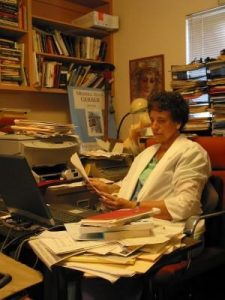
Today we’d like to introduce you to Merrill Joan Gerber.
Hi Merrill Joan, can you start by introducing yourself? We’d love to learn more about how you got to where you are today?
From the time I could think, I remember always being aware of my personal feelings. When I was three years old, a friend of the family said to me, “My, what a big girl you are!” and I knew at once this was wrong and not true. I was a very small girl, I couldn’t reach anything high, I couldn’t walk freely in my neighborhood, I wasn’t able to get food for myself, and I needed help with almost everything. It also occurred to me that perhaps this woman wasn’t too bright. Quite early in my life, I made the decision to decide for myself what was true and not to let anyone around me tell me how I should feel about whatever was happening.
As soon as I learned how to write, I had an impulse to describe what I was feeling, thinking, and what being alive meant, in my specific case, to me. When I was twelve, my father bought for me my first typewriter and set it up for me on a card table in the basement of our Brooklyn house.
When, at age thirteen, I was asked by a boy in my class to go to the movies, I thought about writing a story as soon as I got home. On my beloved typewriter, I described how I felt getting dressed for the event, what color lipstick (Pixie Pink!) my mother let me wear, how grownup it felt to be allowed to walk the one block to the theater on Ave P and to sit next to the boy (“Charles”) while we watched the afternoon movie whose title I can no longer remember. Something whole and new had happened to me, and I wanted to get it down, record it, and be able to remember it in detail.
“A writer is one upon whom nothing is lost,” said Henry James, and a great writing teacher I had at college advised us that “Everything is grist for the mill,”—meaning that even unpleasant experiences, losses, even grief, will be there to be called on when you want to write about these subjects.
I grew up in Brooklyn, New York, and my family moved to Miami Beach when I was about to start tenth grade. By then, I had already experienced fear (I had had pneumonia four times in my first year of high school and remembered clearly the terror of standing before a fluoroscope machine in my doctor’s office, my naked back pressed against a cold metal screen. I had experienced great love (for my Beagle dog, Spotty, whom we had to give away when we moved to Florida), so I also knew the grief of loss. I wanted to write down, to the depth of my understanding, all these experiences.
I graduated from Miami Beach High School, attended the University of Florida in Gainesville, Florida, and there I took my first writing class with a teacher who astonished me with his talent and intelligence. He did what great teachers are born to do: excite a passion in the hearts of his students. My professor had written a novel and inscribed it to me with these words: “To Merrill Joan Gerber, who has great promise as an artist.” I wrote many stories for his class and published my first story called “The People in China” in “The Florida Review,”—the literary magazine of the university.
I went to grad school at Brandeis University, married my high school sweetheart in 1960, and in 1962, gave birth to my first daughter. It was then, just a few months after my daughter was born that I won a Stegner Fellowship to the famous writing program at Stanford University in California, where Wallace Stegner was to be my teacher.
My husband, our baby and I flew to California and in the writing workshop, I wrote a story about my most recent experience: the birth of my baby and my mother’s visit to come and stay with us and “help out.” In actual fact, my mother didn’t help at all. I felt she was intrusive, she invaded our precious privacy as a brand-new family, she didn’t want me to nurse the baby and took over against my wishes. Thus, with this powerful experience still resonating within me, I wrote the story titled “A Daughter of my Own.” I was far away from my mother then and wrote with all the feeling and honesty I could muster about this ordeal. I sent the story to Redbook Magazine, and within a couple of weeks, I got news that they wanted to publish it! And that they would pay me $1000!
What joy that was…until I realized, finally, that Redbook Magazine had eight million readers and that my mother would, of course, find my story in some drug store or dentist’s office. When I received the check for the story, I sent the money to my mother, assuring her that whatever she felt when she read the story, she must remember that it was fiction and that I loved her dearly.
The second story I wrote in the Stanford workshop was about a family funeral I had experienced when my father’s older brother had died suddenly. That story I submitted to The New Yorker, and behold! They too wanted to buy it and publish it. How easy I thought the writing life would be! Type a dozen pages, send it off somewhere, and get a big check!
Well, here I am years later, having written many other stories that were published but also having collected dozens of rejections along the way for stories that did not get published. I have loved the life of being a writer and of being a teacher of writing (both at Pasadena City College and at Caltech). I’ve published 31 books in all: collections of stories, novels, memoirs, and several young adult books. My archive of papers, including all the manuscripts, notes and letters I’ve saved over the years, is now at the Yale Rare Book Library.
There is only one way to become a writer—not to dream about being one, but to sit down every day at your keyboard, organize the truths you want to write about, and do it!
Would you say it’s been a smooth road, and if not what are some of the biggest challenges you’ve faced along the way?
Most writers collect dozens, or even hundreds, of rejections when they begin to submit their work to be published. Dealing with these turn-downs is a badge of battle for every writer. In time, writers learn to ignore the traditional, “Sorry, this is not right for us, but we’re sure someone will be happy to publish it.” Whatever the reason they may tell you for turning your work down, the bottom line is the editor feels it’s not going to make money for the company. They may say they don’t know how to market it. Or they tell you they have several such stories/essays/novels already lined up for publication. The writer tosses these rejections into a box and turns back to her desk to do her work.
Can you tell our readers more about what you do and what you think sets you apart from others?
Most writers require an agent who will submit their work for them. Agents serve as filters for publishing houses, doing the initial work of sending your writing to places that might be most receptive to it. To find an agent, search online for “Literary Agents” and you will find many suggestions for how to match up with one. Long ago, when publishers had special employees who acted as “first readers,” a writer was able to send her work directly to the publisher or magazine, or “over the transom” as it was called. Now many places will read only writing submitted to them by an agent.
The first agent who represented me, when I was barely out of my teens and was writing young-adult stories, happily sold a number of them to teen magazines. When I later offered him a story based on my grandmother, in her old age and illness, and who was in a nursing home, he wrote me that it was “too maudlin” and that I should continue to write my teen stories. I told him I would handle my own stories from then on and dismissed him as my agent. I sold that story to Mademoiselle magazine myself. Some years later, I found a sympathetic and more suitable agent who I worked with for many years.
What’s next?
Now that I have retired from teaching and have published thirty-one books, including novels, stories, essays, memoirs and poems, I am waiting to see what inspires my next engagement with writing. Over my lifetime, I have stayed connected–by writing letters and now emails– with many editors and writers, friends from elementary school, high school, college, graduate school and beyond. I have enjoyed writing many op-ed pieces and a good many complaint letters to companies who products have failed me! A writer is always poised to write the next thing that comes to mind. From the days of pen in hand to typewriter with a new ribbon, to the first floppy-disk computer, and now to a high-tech, high-resolution colored-screen laptop, I am ready to write what comes next.
Contact Info:
- Email: merrillgerber@yahoo.com
, mjgerber@caltech.edu - Webpage: www.MerrillJoanGerber.com
























